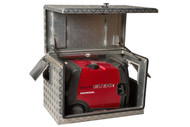Correct Storage Preparation For Your Generator
20th Jun 2019
Proper storage preparation is essential for keeping your generator trouble free and looking good. The following steps will help to keep rust and corrosion from impairing your generators function and appearance, and will make the engine easier to start when you use the generator again.
Cleaning - Wipe your generator with a moist cloth. After the generator has dried you can touch up any damaged paint, and coat other areas that may rust with a light film of oil.
Fuel - Depending on the region where you operate your equipment, fuel formulations may deteriorate and oxidize rapidly. Fuel deterioration and oxidation can occur in as little as 30 days and may cause damage to the fuel system. Fuel will oxidize and deteriotate in storage. Old fuel will cause hard starting, and it leaves gum deposits that clog the fuel system. If the fuel in your generator deteriorates during storage, you may need to have the fuel system components serviced or replaced. The length of time that fuel can be left in your fuel tank without causing functional problems will vary with such factors as fuel blend, your storage temperatures, and whether the fuel is partially or completely filled. The air in a partially filled fuel tank promotes fuel deterioration. Very warm storage temperatures accelarate fuel deterioration. Fuel deterioration problems may occur within a few months, or even less if the gasoline was not fresh when you filled the fuel tank.
Drain the Fuel Tank - This can be done a few ways, by siphoning out the fuel from the top of the tank , though the filler hole, or locating the drain screw on the bottom of the carby and let the fuel drain out into a plastic container.
Fuel Stabilizer - Another option is to use a fuel stabilizier which will keep your fuel fresh for up to 24 months.
Engine Oil - Change the engine oil, remove the spark plug and pour a teaspoon of clean oil into the cylinder. Pull the starter rope several times to distribute the oil in the cylinder. Re-install the spark plug. Slowly pull the starter rope until resistanace is felt. At this point the piston is coming up on its compression stroke and both the intake and exhaust valve are closed. Storing the engine in this position will help to protect it from internal corrosion.
Battery - If your generator model has a battery fitted, charge the battery before storing an recharge the battery every month.
Storage Precautions - If your generator will be stored with fuel in the fuel tank, it is important to reduce the hazard of fuel vapour ignition. Select a well ventilated storage area away from any appliance that operates with a flame, such as a furnace, water heater etc. Also avoid any area with a spark-producing electric motor. If possible avoid storage areas with high humidity, beacause that promotes rust and corrosion. Place the generator on a level surface, as tiliting can cause fuel or oil leakage. With the engine and exhaust system cool, cover the generator to keep out dust. A hot engine and exhaust system can ignite or milt some materials. Do not use sheet plastic as a dust cover. A non porous cover will trap moisture around the generator, promoting rust and corrosion.
Removal from Storage - If the generator was stored for 1 year or longer with fuel, drain the fuel tank and refuel with fresh fuel. If you keep a container of fuel for refueling, be sure that it contains only fresh fuel. If the cylinder was coated with oil during storage preparation, the engine may smoke briefly at startup, this is normal.





